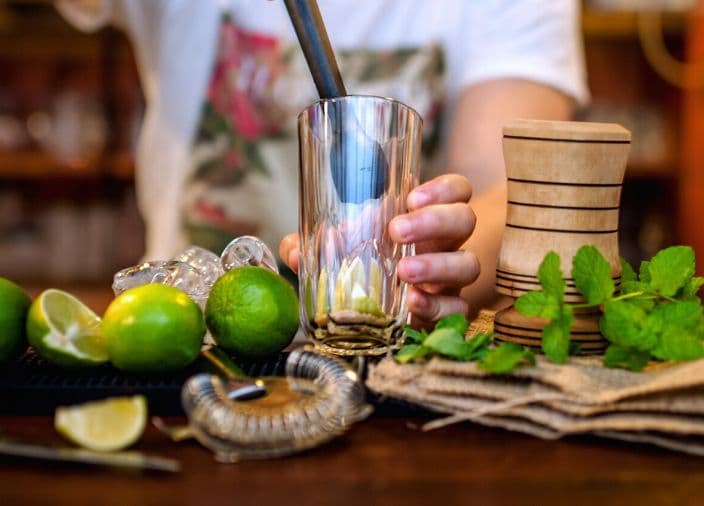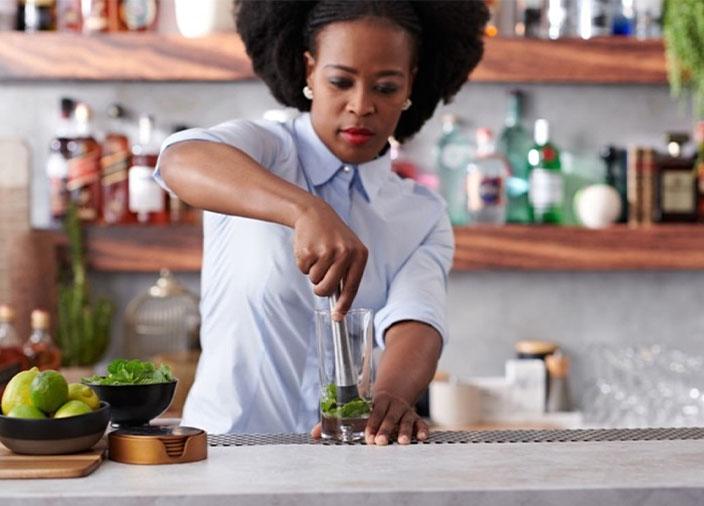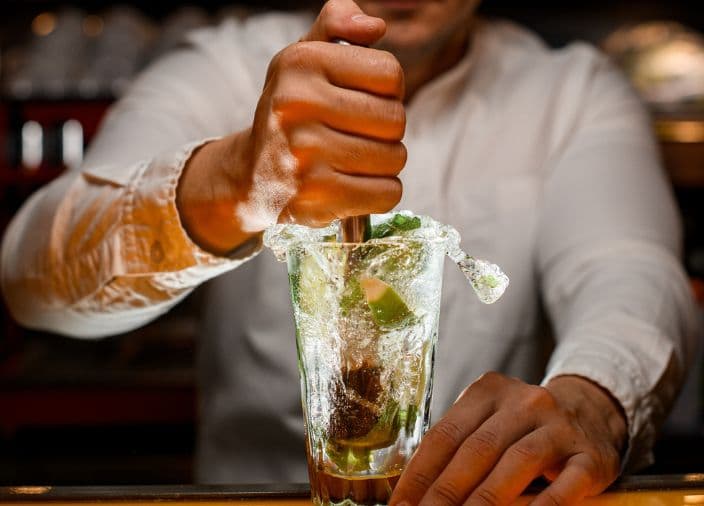BECOME A MUDDLING MAESTRO
Discover how to muddle for cocktails and master using this skill to enhance the flavour of your serves.
Estimated reading time: 6 minutes
MUDDLING: A QUICK HISTORY
The act of muddling can be traced back centuries. Various cultures across the world used muddling-like methods to craft medicinal drinks, crushing herbs and plants to extract their beneficial properties.
The muddler was originally known as a ‘toddy stick’ due to its use when mixing ingredients for its namesake, a Hot Toddy cocktail. It soon became known as a muddler and by the 1850s its use was widespread. It’s now one of the oldest known tools in a mixologist's kit.
Fast forward to the world of cocktails, muddling really started trending with the rise of the Mint Julep in the American south and the Mojito from Cuba. Both require bartenders to gently press mint leaves to release their aromatic oils, turning muddling into a bar industry artform to master.

BRING YOUR INGREDIENTS TO LIFE
Muddling is a hands-on technique that’s been around since cocktails were first invented.
The muddling process involves pressing and sometimes lightly bruising your ingredients to release their inner flavours and oils, adding a deeper profile to your drinks. By doing this, the flavours of your ingredients can blend better with the alcohol for a tastier cocktail.
It’s a great way to really bring cocktail ingredients like sugar, herbs, fruit, and peel to life.
THE ART OF MUDDLING
Don't underestimate the complexity of muddling; there's more to it than just crushing ingredients in your glass. Follow these key techniques to serve the perfect muddled drink every time.
- Gentle Pressing: The key is to press ingredients just enough to extract flavours without demolishing them. Avoid over muddling as too much force can ruin your drink. For instance, muddling mint requires a delicate touch to release the oils without tearing the leaves, which can result in bitterness.
- Circular Motion: This ensures an even extraction of flavours. Twist ingredients against the sides of the glass or shaker to optimise the release of essential oils or juices.
- Layered Muddling: When muddling multiple ingredients, it's crucial to understand which ones require a firmer press and which require a gentler touch. This might mean muddling in stages.

Watch this video and follow our simple steps to making a perfect mojito.
MUST-HAVE MUDDLING EQUIPMENT
- The Muddler: The star of the show, a muddler is typically made of wood, stainless steel, or plastic and comes in various sizes and shapes. Some have a flat base, while others are toothed. The choice often depends on your preference and the ingredients you're muddling.
- Mixing Glass or Shaker: A sturdy vessel is needed to withstand the pressure of muddling, especially when you’re working with harder ingredients like raw sugar cubes or thick fruits.

Muddle Like a Master
Fine-tune your muddling skills to create fragrant and delicious cocktails to stand out in a competitive environment. Follow these best practices to be at the top of your game,
- Clean Ingredients: Always ensure that fruits and herbs are thoroughly cleaned. This is not just for hygiene but also to ensure you don't add external flavours to the drink.
- Understand Ingredient Texture: Softer ingredients, like berries or citrus segments, require less force than firmer ingredients, such as cucumbers or raw sugar. Chop ingredients like fruit into small pieces to make muddling easier.
- Equipment Care: If using a wooden muddler, avoid soaking it for long periods to prevent it from becoming waterlogged. You can also wipe it down with food-safe oils to aid in water resistance. Regular cleaning of any muddler type ensures flavours aren't transferred between cocktails. To keep your glassware safe, avoid muddling in a stemmed glass.
To perfect your muddling technique, practice it with this Captain Morgan’s Mojito Recipe. Using mint leaves that need a delicate touch and firmer lime wedges gives you a great opportunity to train your layering.
To learn more about other advanced bar techniques that can supercharge your performance, join Diageo Bar Academy to access exclusive expert tips and tricks.
Key Takeaways
- Muddling is an ancient art that's been used for centuries to extract oils and flavours for drinks and medicine.
- When muddling ingredients, you want to be gentle enough to not destroy the fruit or herbs. Over-muddling can add bitterness and other unwanted flavours to your drink.
- The muddler is a key piece of equipment that can come in different materials and sizes. Keep it clean between uses to ensure you don't mix in different flavours when muddling.
- Understanding the textures of ingredients can make you better at muddling. Firm citrus fruits need more force when muddling, while delicate herbs like mint need less.
